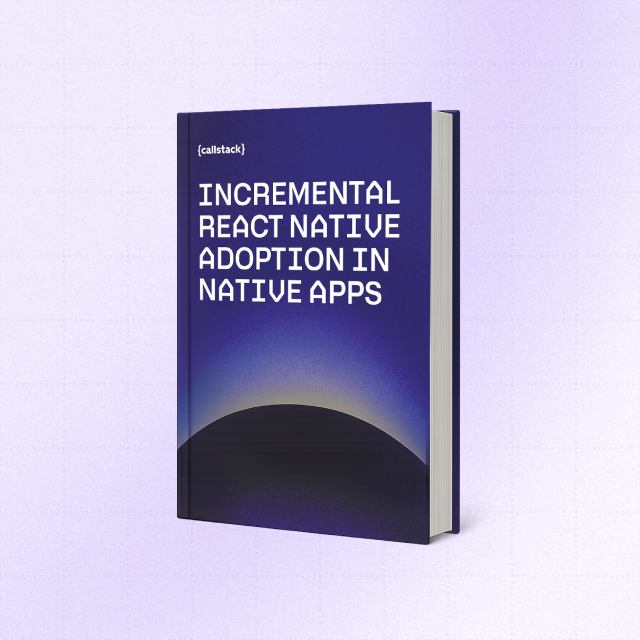
Integrate React Native with your native application








If you have an existing application, you don't have to start from scratch. You can add React Native to existing native codebase and benefit from cross-platform features immediately.

Why you should add React Native into existing native application
Unlike most cross-platform frameworks, React Native works alongside your existing native code, letting you adopt it incrementally and keep full access to platform APIs. It’s a practical way to go cross-platform without starting over.
Incremental adoption
Add React Native to one screen, tab, or section. Expand only when needed. No need to change what already works.
Incremental adoption
Add React Native to one screen, tab, or section. Expand only when needed. No need to change what already works.
Shared codebase
Share logic, components, and infrastructure across platforms. Cut mobile effort without cutting corners.
Shared codebase
Share logic, components, and infrastructure across platforms. Cut mobile effort without cutting corners.
Reliable performance
Properly integrated React Native matches native speed for most use cases, and users won’t notice the switch.
Reliable performance
Properly integrated React Native matches native speed for most use cases, and users won’t notice the switch.
Shopify migrated to React Native to move even faster
Shopify started their migration to React Native over five years ago with existing iOS and Android apps. While they share significant portion of the codebase, they plan to keep brownfield integration for foreseeable future.
80%
Code shared across all platforms
2M+
Lines of code removed

What should you watch out for when integrating React Native into a native codebase?
Brownfield React Native integration gives you flexibility, but getting it right requires careful coordination between native and JavaScript environments. These are the most common issues we help teams avoid in production.
Integration complexity
Integrating React Native into a native codebase requires managing build tooling, platform configs, and collaboration between native and JS teams.
Startup time
Improper JS engine initialization can delay app launch or cause first-screen jank-timing and thread strategy matter.
Syncing data
Native and JS often share state like auth, navigation, or flags. Misalignment leads to bugs, logic duplication, and degraded UX.
Bundle size impact
Without stripping unused modules or lazy-loading, React Native adds binary weight-slowing cold starts and increasing memory use.
Release coordination
React Native introduces new release steps, such as bundling JavaScript and OTA updates, that must be aligned with native builds.
Migration strategy
Teams often start small but quickly expand React Native usage. Without a clear plan, divergent patterns, or inconsistent architecture can slip through.

Bring React Native into your app, one step at a time
Adopting React Native in a native app? This is the guide you’ve been looking for. This ebook offers a full walkthrough of how to embed React Native in iOS and Android projects, screen by screen, without slowing delivery or rewriting the whole app. It covers:
- How the Packaging Approach and React Native Brownfield library simplify setup
- Step-by-step walkthroughs for iOS and Android
- Real-world migration insights from the Callstack team
Hire experts to integrate React Native into your native app
Integrate React Native with existing native application
Whether it’s one screen or a multi-step flow, we make sure it fits your architecture and release process.
Improve performance of existing React Native integration
Identify and fix performance issues caused by how React Native is integrated into your native app.
Ship faster with our engineers on board
Get our React Native engineers on your team and deliver new features while gradually expanding React Native’s footprint.
Upskill your native engineers with React Native
Train your native engineers with all React Native best practices, from component design to debugging and performance tuning, so they can take full ownership of the codebase moving forward.
Get React Native running in your existing mobile application in a week!

Why leading companies work with Callstack
Meta Official Partners
We are official Meta partner for React Native, co-organizers of React Conf and hosts of React Universe Conf.
Working at scale
We know how to make React Native work at enterprise scale, both technically and organizationally.
React Native Core Contributors
We don’t just use React Native to build cross-platform apps, we help shape it for millions of developers.
Team at scale
We’re a team of 200+ engineers ready to start fast and scale with your needs.
Enterprise-friendly
We hold ISO certifications and follow strict security standards to make onboarding smooth and compliant.
Wide range of services
As a partner for your full application lifecycle, we offer a full range of services around React and React Native.

FAQs
Brownfield setups can raise a lot of technical and strategic questions. Here are answers to the ones we hear most, so you know exactly what’s involved, what it takes, and how we can help.
No. React Native can be added to your existing app without rewriting what already works. We help you isolate the right entry point, like a tab, screen, or flow, and integrate it cleanly.
In most cases, we can get a basic integration running in production in under a month. This includes setup, native bridge configuration, and one working feature or screen.
We configure the React Native runtime, set up your bundling and build pipeline, embed RN into native navigation, and ensure shared data flows correctly across layers.
React Native introduces JavaScript updates into your mobile stack, but your native release process remains intact. We help you align both pipelines and set up CI to catch issues early.
Yes, and that’s often the best approach. We recommend starting with a low-risk area of the app, so your team can evaluate performance and DX before scaling.
We support brownfield integration for both Android and iOS. We’ll tailor the setup based on your app’s architecture, navigation, and platform constraints.
Absolutely. We provide handoff documentation, training, and pairing sessions to make sure your iOS and Android engineers can work confidently with React Native.
We can audit your existing setup, improve performance, and help you scale it safely. We often work with teams who started small and want to extend React Native use across the app.
We can help you add React Native into your tech stack
We’ve worked with teams running high-traffic native apps to bring React Native without blocking releases or adding risk.
We’ve helped dozens of teams go cross-platform without rewriting everything. Let's see how we can help you.
